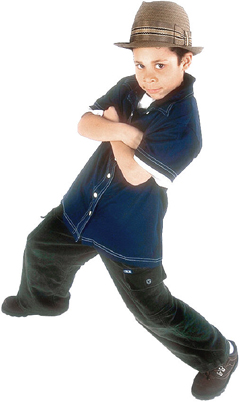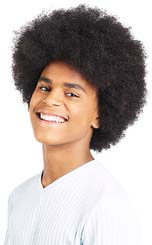|
Intermix.org.uk is a website for the benefit
of mixed-race families, individuals and anyone who feels they have a multiracial
identity and want to join us. Our mission is to offer a view of the mixed-race experience, highlighting icons, film, books, poetry, parenting techniques, celebrities, real lives and much more. Our online forums are a great place to meet others, ask questions, voice your opinions and keep in touch. Sign up for our monthly newsletter and delve into our pages. Want to join in? Become an Intermix member to take part: |
Is That Your Kid?
By Jon Lewis-Katz
 There’s
only one hard and fast fact about life growing up with a white father
and black mother: What feels real is real when it comes to racial identification.
There’s
only one hard and fast fact about life growing up with a white father
and black mother: What feels real is real when it comes to racial identification.
One spring afternoon, I stood on the
curb and watched my older cousin, who is actually my mother’s cousin’s
son, hail a cab. Or, I should say, try to. For some reason, regardless
of whether it held passengers, no taxi stopped for him.
With each failed attempt, I took a step toward the street. Soon, I was
in front of him, my right arm extended into 6th Avenue traffic. The first
cab at which I motioned stopped.
Inside, my cousin, who is black, explained how he gets cabs where he lives,
in our nation’s capital. Though he dresses well, in clothes that
fit him and have the names of well-known white designers on the labels,
cab drivers rarely stop for him.
Occasionally, one will and when that happens,
he adds the driver’s name and number to a list. On Friday afternoons,
he dials the cabbies on the list hoping that one of them is on duty that
night. If not, he stays in rather than drive drunk.
All this just to catch a cab, I thought as we passed Madison Square Garden.
All this, that, because I’m light skinned, I’ve never had
to deal with.
I grew up in Pacific Palisades, where I was one-half of the one and a half
black kids in my neighbourhood. There were, of course, others. Three, maybe
four more of us, besides the kids who rode in on LAUSD buses. But it felt
like we were the only ones. In a way, Sean and I were privileged. We were
the only two kids in our Episcopalian school allowed to use the N-word.
We were the only ones who had the right to wear baggy clothes. The only
ones with a claim to rap music. In short, we were the two admitted to the
VIP room of racial stereotypes.
Nevertheless, outside the tiny universe populated by my mostly white schoolmates
and their parents, I was reminded that my mom’s skin was much darker
than mine. I frequently accompanied her on shopping excursions that took
us out of the neighbourhood, to places filled with people who looked more
like my mom than I did. It was then — shopping for clothes, bikes,
groceries — that I heard my mom repeatedly asked the same question:
'Is that your kid?' Even in our community, at my sports games, people
would commonly mistake my mom for my nanny.
As a young child, the idea of race was never explained to me the way reproduction
or the multiplication tables were. I think this was my parents’ attempt
to shelter me. Still, though I lacked racial terminology, I was aware of
skin colour from a very young age. 'Why don’t I look like you?' I
asked my mom after examining my eyes or lips or nose in the mirror. I don’t
remember what she said but I recall that it was inadequate. How can you
explain to a young child the crapshoot of genetics?
My mom never appeared bothered by the questions people asked. 'Yes, he’s
my son,' she’d say. 'Or, no, I’m not my son’s nanny'.
She was also struggling with racial issues of her own.
She came to this country from the Caribbean at the age of 18 and, more
than 40 years later, continues to resist how Americans define race. When
I called her African American, she said, 'I’m West Indian,' meaning
that she’s from the Caribbean. When I asked why blacks nodded to
her on the street, she said, 'It’s something blacks in this
country do.'
My mom, though she’s brown skinned, has a foreign accent and is usually
accepted by whites and blacks. I, on the other hand, found I was an outsider
with strangers from both groups. Blacks often openly discriminated against
me while whites unknowingly pushed me away by making subtly racist comments
(I can’t count the times I’ve heard the phrase, 'Big
black guy').
Probably because she rejected American racial values, my mom always reminded
me that I was not black nor white but mixed. My mom’s line, however,
either met ridicule (I once asked a light-skinned African American kid
what flavour Gatorade he was drinking. 'Citrus,' he said. 'Like
you.') or was deemed insufficient ('So then, what are you?' they
asked, repeating the question I’d thought I just answered. 'My
mom’s black, my dad’s white,' I said.).
As I grew, my skin tone didn’t change and even though my nose grew
a little wider, my lips a little thicker, strangers continued to perceive
me as white until I went to college in New York City. If you’re multi-racial,
New York is easier to live in than Los Angeles because there’s more
diversity and less segregation. There, for the first time, I interacted
with the Caribbean-American community and, noticing the cultural differences
between blacks from the Caribbean and African Americans, I thought I began
to understand why my mom insisted she was West Indian. More importantly,
I shared subway cars and sidewalks with Puerto Ricans, Dominicans, Trinidadians,
Mexicans — all of whom have a tradition of racial mixing.
I was no longer perceived as white. I’d become racially ambiguous.
In airports I was, unfortunately, Middle Eastern. In the Italian section
of Williamsburg, Brooklyn, I was Italian. In job interviews, after potential
employers saw my last name, I was Jewish. In Spanish-owned delis, Puerto
Rican. 'Tres dòlares,' the woman at the register would
say to me. Of course, this change came with its own burden. No longer racially
fixed, people based assumptions about me on the clothes I wore, the people
I walked with, the neighbourhood I walked in. Still, because few people
were sure what I was, I was rarely faced with overtly racist comments.
In October, when I moved back to Los Angeles, I finally learned why my
mom had never let herself be labelled black. She, too, was multiracial.
East Indian, French Creole, Scottish and, yes, African — all these
bloods run in her veins. If she had told me before, I’d been too
young to listen.
Gradually, between October and February, I realized that in all my attempts
to wrestle down a racial identity, I’d learned that to be racially
mixed is to be made up of a contradiction: your mom’s race, your
dad’s race and, therefore, neither his nor hers. This is different
than to repeat that line about race labels being false, to say that the
labels 'white' and 'black' are theoretical. What
feels real is real. It is to say that I will never be completely black.
I will never be completely white. I may be West Indian, I may be Jewish,
but, racially, I am forever an outsider. It is my place.
Source:Pasadenaweekly.com
:
